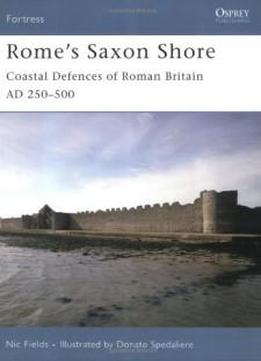
Rome's Saxon Shore: Coastal Defences Of Roman Britain Ad 250-500 (fortress)
by Nic Fields /
2006 / English / PDF
20.1 MB Download
Although the exact dates of construction of the so-called Saxon
Shore forts are uncertain, the development of the frontier system
that ran form the Wash to the Solent on the south-east coast of
Roman Britain was spread over at least a century and a half. Many
of the new forts were notable for the superior strength of their
defences, with thicker stone walls bristling with projecting curved
bastions. These and other features were clearly designed to them
more difficult to storm than old-style frontier forts with their
classic playing-card shape and internal towers. Defense earlier in
the Roman era had meant aggressive response in the open field or
even offensive pre-emptive strikes into enemy territory. The new
trend was to build stronger, the emphasis being on solid, more
static defense, anticipating attack and absorbing it rather than
going out to meet it. Most of the major harbours and estuaries of
the east and south-east coasts of Britain were fortified in this
manner. There was a similar series of military installations across
the Channel in Gaul, extending along the northern coast as far as
what is now Brittany.
Although the exact dates of construction of the so-called Saxon
Shore forts are uncertain, the development of the frontier system
that ran form the Wash to the Solent on the south-east coast of
Roman Britain was spread over at least a century and a half. Many
of the new forts were notable for the superior strength of their
defences, with thicker stone walls bristling with projecting curved
bastions. These and other features were clearly designed to them
more difficult to storm than old-style frontier forts with their
classic playing-card shape and internal towers. Defense earlier in
the Roman era had meant aggressive response in the open field or
even offensive pre-emptive strikes into enemy territory. The new
trend was to build stronger, the emphasis being on solid, more
static defense, anticipating attack and absorbing it rather than
going out to meet it. Most of the major harbours and estuaries of
the east and south-east coasts of Britain were fortified in this
manner. There was a similar series of military installations across
the Channel in Gaul, extending along the northern coast as far as
what is now Brittany.
Whatever their precise tactical and strategic function, a
continuing debate to which this book contributes, the construction
of these stone forts represented a huge outlay of money, and
commitment of manpower and materials. The Saxon Shore Forts are
among the most impressive surviving monuments of Roman Britain.
This book addresses a number ofthe fascinating questions they
provoke - Who built these Forts? When and for what purposes? How
were they built? How did they operate? Who garrisoned them, and for
how long?
Whatever their precise tactical and strategic function, a
continuing debate to which this book contributes, the construction
of these stone forts represented a huge outlay of money, and
commitment of manpower and materials. The Saxon Shore Forts are
among the most impressive surviving monuments of Roman Britain.
This book addresses a number ofthe fascinating questions they
provoke - Who built these Forts? When and for what purposes? How
were they built? How did they operate? Who garrisoned them, and for
how long?











